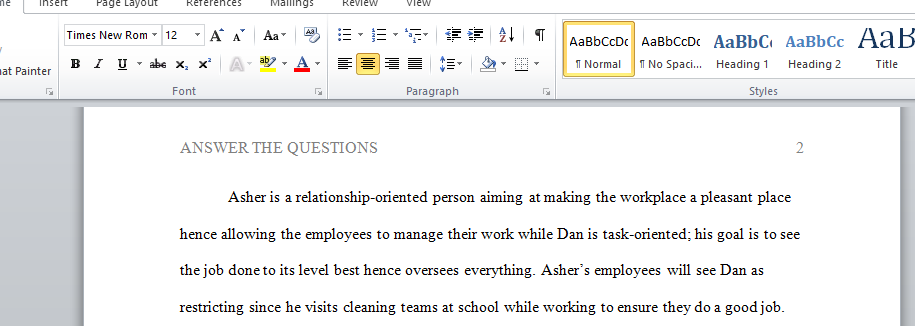Explain task oriented and relationship oriented
CHAPTER 5 NOTES
TASK ORIENTED AND RELATIONSHIP ORIENTED
Task Oriented
When we look at what leaders do— that is, at their behaviors— we see that they do two major things: (1) They attend to tasks, and (2) they attend to their relationships with people.
The essence of leadership behavior has two dimensions— task behaviors and relationship behaviors.
Certain circumstances may call for strong task behavior, and other situations may demand strong relationship behavior, but some degree of each is required in every situation.
Task-oriented people are goal oriented.
Doing tasks gives people a sense of control and self-mastery. Achievement sharpens our self-image and helps us define ourselves.
Some clear examples of task-oriented people include those who use color codes in their daily planners, who have sticky notes in every room of their house, or who, by 10: 00 on Saturday morning, have washed the car, done the laundry, and cleaned the apartment.
Common to all of these people is their interest in achieving the goal and accomplishing the work.
Task leadership behaviors facilitate goal accomplishment.
some have labeled task leadership as initiating structure, which means the leader organizes work, defines role responsibilities, and schedules
production orientation, which means the leader stresses the production and technical aspects of the job (Bowers & Seashore, 1966). From this perspective, the leader pays attention to new product development, workload matters, and sales volume, to name a few aspects.
A third label for task leadership is concern for production (Blake & Mouton, 1964). It includes policy decisions, new product development, workload, sales volume, or whatever the organization is seeking to accomplish.
In short, task leadership occurs anytime the leader is doing something that assists the group in reaching its goals.
Task leadership includes many behaviors: Common to each is influencing people toward goal achievement.
Relationship Oriented
Essentially, relationship leadership behavior is about three things: (1) treating followers with dignity and respect, (2) building relationships and helping people get along, and (3) making the work setting a pleasant place to be. Relationship leadership behavior is an integral part of effective leadership performance.
Relationship-oriented people differ from task-oriented people because they are not as goal directed. The relationship-oriented person finds meaning in being rather than in doing.
They find meaning in the moment rather than in some future objective to be accomplished.
Basically, they are into connectedness.
relationship-oriented person would not be afraid to interrupt someone who was working hard on a task to talk
good leaders understand the work that needs to be done, as well as the need to understand the people who will do it.
Relationship leadership behaviors help followers feel comfortable with themselves, with each other, and with the situation in which they find themselves.
build camaraderie, respect, trust, and regard between leaders and followers.
relationship leadership as having an employee orientation, which involves taking an interest in workers as human beings, valuing their uniqueness, and giving special attention to their personal needs.
The challenge for a leader is finding the time and energy to listen to all followers and do what is required to build effective relationships with each of them.
Change – In Leadership
researchers found that change behaviors included visioning, intellectual stimulation, risk taking, and external monitoring. This category of behaviors has been less prominent in the leadership literature but still is a valuable way to characterize what leaders do.
In the end, the best leader is the leader who helps followers achieve the goal by attending to the task and by attending to each follower as a person. They are the managers who never let us slack off for even a second but who make work a fun place to be.
Northouse, Peter G.. Introduction to Leadership: Concepts and Practice (Kindle Locations 4006-4009). SAGE Publications. Kindle Edition.
CHAPTER 6 NOTES
LEADERSHIP SKILLS
Leadership skills refer to learned competencies that leaders are able to demonstrate in performance.
Leadership skills give people the capacity to influence others.
leadership skills are grouped into three categories:
1 administrative skills 2 interpersonal skills 3 conceptual skills
ADMINISTRATIVE SKILLS (admin, interpersonal, & conceptual skills)
Administrative Skills Explained While often devalued because they are not glamorous or exciting, administrative skills play a primary role in effective leadership. Administrative skills help a leader to accomplish the mundane but critically important aspects of showing leadership. Some would even argue that administrative skills are the most fundamental of all the skills required of a leader.
What are administrative skills?
Administrative skills refer to those competencies a leader needs to run an organization in order to carry out the organization’s purposes and goals.
These involve planning, organizing work, assigning the right tasks to the right people, and coordinating work activities.
Administrative skills are divided into three specific sets of skills: (1) managing people, (2) managing resources, and (3) showing technical competence.
1 of 3 Managing people (ADMIN SKILLS)
Few leaders can do without the skill of being able to manage people. The phrase management by walking around captures the essence of managing people. An effective leader connects with people and understands the tasks to be done, those skills required to perform them, and the environment in which people work. The best way to know this is to
Answer preview:

Words:303
